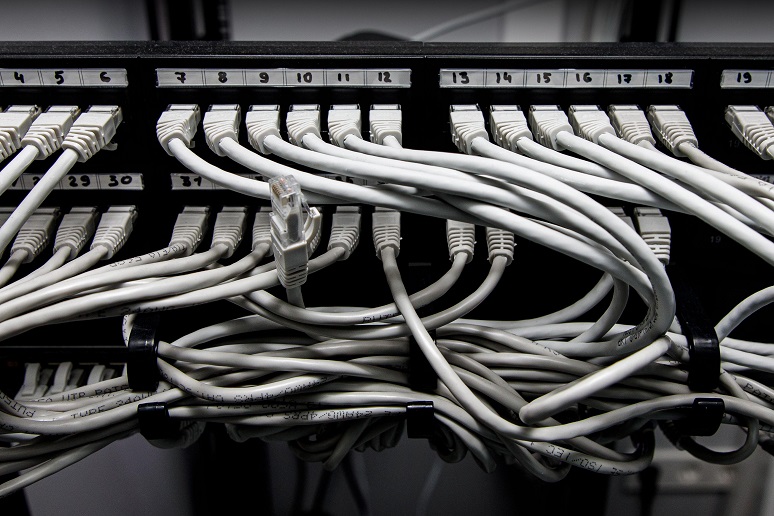As telecommunications services continue to evolve, your office space (or office building) likely contains remnants of the past in the form of unused cabling infrastructure and its associated electronics. Why care about this? It is much easier to look the other way, but here are some reasons you may want to focus on this unused infrastructure and consider removing it.
You Can Recapture Valuable Space
The unneeded cable may be in one area of a room or may take up the entire room. The cabling mounted on wall space or in free-standing racks may no longer be in use. Often when new services are installed, they're located elsewhere. And newer services typically take up a lot less space. Once unneeded cables are removed safely, you can use the valuable space for something else.
It Will Improve Appearances
Cabling infrastructure—meaning the actual cable and associated connectors—is never pretty. While much of it may be in a separate room, cabling and associated connectors are often mounted on office walls in open areas (sometimes referred to as “intermediate distribution frames”). As with cabling inside a separate room, this exposed cabling may no longer be in use and therefore can be removed.
You’ll Stop Paying for Communications Services No Longer in Use
Often older cabling infrastructure carries communications services that are no longer needed. It is all too common to discover that when newer types of communications services are put in place, the services they replaced remain. This results in unneeded circuits continuing to operate and to bill monthly. In some cases, even when disconnect orders are placed with the communications service provider, the orders are not properly completed and billing continues. These services may be labelled on what is called a demarc (point of demarcation), which is how the pairs of wires on each cable are terminated.
You Can Stop Paying for Costly Power No Longer Needed
Many types of communications services require accompanying devices powered by electricity. Even after a circuit has been removed, the electronics may continue to operate and use electric power. The devices (often cabinets holding printed circuit boards) many not necessarily be labelled with the circuit number, but the circuit at the demarc may have had a tag indicating the rack, cabinet or slot number where the corresponding circuit board can be found.
You Can Identify the Important Services More Easily
There may be cases where critical services you need to keep are delivered in the same area as services that are no longer needed. It is obviously important to distinguish between the two. Needed services are often hard to find when mixed in the same area with discontinued services.
You’ll Improve Troubleshooting Capability
Having out-of-date circuits and cabling mixed with current services can cause confusion and slow down restoral of needed services. Clear labelling of your communications services becomes critical when circuits go out of service.
In order to accomplish this type of cleanup, you’ll need the following help:
- First, find a telecommunications technician who can test each circuit on a cable to see if it is working.
- If a circuit is labelled with a circuit number, log the number so that you can determine whether or not it is needed.
- If a circuit is not labelled, but the technician determines that it is a live circuit, your communications service provider will need to come out to identify the circuit number. (If you have more than one communications service provider, you may need to enlist support from each of them.)
- Once circuits have been identified, someone needs to correlate the circuit number to a monthly invoice, then determine whether or not it is in use. Unneeded circuits can be removed.
- Once it is determined that a cable is no longer carrying any live circuits, it can be removed.
- Before removing unneeded cabling infrastructure, you may want to consolidate needed services in use to a new location.
To avoid getting back to the same situation in the future, keep track of the following for each of your telecommunications circuit numbers:
- Circuit number (or numbers, more than one identifier per circuit in some cases)
- Service Provider Name
- Corresponding account number
- Corresponding service provider contract
- Physical location on the demarc (end of the cable)
- Associated electronics, their location and identifying numbers
- Purpose of the circuit (Note: A basic ten digit telephone number may be a circuit, Other types of circuits for voice and data often combine a string of letters and numbers.)
To maintain the integrity of these records, assign the responsibility to one person within your organization or to a communications consultant. Input is always needed from more than one person, so identify who has the following responsibilities:
- Who maintains the relationship with each communications service provider? Different people within your organization may interact with different providers.
- Who is responsible for negotiating contracts with the communications service provider?
- Who manages the contracts to be sure they are adhered to?
- Who places orders to add, change or disconnect services?
- Who follows up to be sure that the orders are completed?
- Who makes sure that the billing is correct and compliant with the contract when the order is complete?
- Who is responsible for approving and paying service provider invoices?
To keep the records up to date, this group of people needs to communicate the details to each other.
Smaller organizations can use Excel or a database program to keep track of the records. Larger organizations often use the services of companies that provide what are often known as technology expense management systems (TEMS), which are large databases that may interact with other systems such as ordering, HR, and accounting. Even the most sophisticated systems need a good amount of care and feeding to ensure ongoing accuracy.
Jane is writing on behalf of the SCTC, a premier professional organization for independent consultants. Our consultant members are leaders in the industry, able to provide best of breed professional services in a wide array of technologies. Every consultant member commits annually to a strict Code of Ethics, ensuring they work for the client benefit only and do not receive financial compensation from vendors and service providers.











